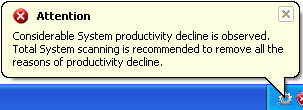Don't Copy From This Blog...
Privacy Guard 2010 is a rogue security program that pretends to scan your computer for malicious code, system and registry errors. It also pretends to check system performance, privacy and Internet settings, so it's kind off a rogue security/optimization program. After the fake scan it will display your system efficiency score which is lower than 40% most of the time. Privacy Guard 2010 will report numerous system and registry errors and of course several viruses. It will also give separate scores for system security, privacy, system utilities, media tools, Internet security and system information. The scores are low as well. Finally, the rogue program will prompt you to pay for a full system clean-up. It will state that your computer will run faster and you will be fully protected against malware. Do not fall victim to this rogue program and uninstall it from your computer as soon as possible. Please follow the removal instructions below to remove Privacy Guard 2010 and related malware for free using legitimate anti-malware software.
Once installed, PrivacyGuard 2010 will display a fake message encouraging you to run the computer in protected mode. Actually, you don't have a choice. This message is:
Protected Mode
Protected Mode has a number of features designed to enhance an operating system's control over application software, in order to increase security and system stability. These additions allow the operating system to function in a way that would be significantly more difficult or even impossible without proper hardware support.

The rogue program will display bogus security alerts and notifications from Windows taskbar that your computer is infected or has some serious problems. The text of some of the fake alerts you may see include:
Critical vulnerability!
Application that seems to be a key-logger is detected. System information security is at risk.
It is recommended to enable the security mode and run total System scanning.

Attention
Software without a digital certificate is detected. System files security is at risk.
It is strongly recommended to enable the security mode.

Attention
Considerable System productivity decline is observed. Total System scanning is recommended to remove all the reasons of productivity decline.

Furthermore, Privacy Guard 2010 will identify legitimate programs as malicious and will block them saying that they do not have digital certificate and pose a potential security risk.

Privacy Guard 2010 will be configured to start automatically when you login to Windows. PrivacyGuard2010 modifies UAC (User account Control) settings in Windows Vista and Windows Seven to bypass the new UAC interface and the administrative task completes without further user interaction. The rogue program may hijack your web browser too.
The home page of Privacy Guard 2010 is privacyguard2010.com (do not visit).

Without a doubt, Privacy Guard 2010 is a scam. All the warnings issued by this program are fake. It's nothing more but a rip-off rogue. If you have already purchased this bogus program, please contact your credit card provider and dispute the charges. I think you should cancel your credit card too if you gave all details to scammers. Then please follow Privacy Guard 2010 removal instructions below. If you have any questions, please leave a comment. Good luck and be safe online!
Privacy Guard 2010 removal instructions:
1. Click Start → Run (or WinKey+R).
2. Type in: cmd and click OK. Command prompt window will show up.
3. Type in: taskkill /f /im PrivacyGuard2010.exe and click Enter. This will stop Privacy Guard 2010.
4. Download free anti-malware software from the list below and run a full system scan.
NOTE: in some cases the rogue program may block anti-malware software. Before saving the selected program onto your computer, you may have to rename the installer to iexplore.exe or winlogon.exe With all of these tools, if running Windows 7 or Vista they MUST be run as administrator. Launch the program and follow the prompts. Don't forget to update the installed program before scanning.
5. New threats appear every day. In order to protect your PC from such (new) infections we strongly recommend you to use ESET Smart Security.
Alternate Privacy Guard 2010 removal instructions (in Safe Mode with Networking):
1. Reboot your computer is "Safe Mode with Networking". As the computer is booting tap the "F8 key" continuously which should bring up the "Windows Advanced Options Menu" as shown below. Use your arrow keys to move to "Safe Mode with Networking" and press Enter key. Read more detailed instructions here: http://www.computerhope.com/issues/chsafe.htm

NOTE: Login as the same user you were previously logged in with in the normal Windows mode.
2. Download free anti-malware software from the list below and run a full system scan.
NOTE: in some cases the rogue program may block anti-malware software. Before saving the selected program onto your computer, you may have to rename the installer to iexplore.exe or winlogon.exe With all of these tools, if running Windows 7 or Vista they MUST be run as administrator. Launch the program and follow the prompts. Don't forget to update the installed program before scanning.
3. New threats appear every day. In order to protect your PC from such (new) infections we strongly recommend you to use ESET Smart Security.
Privacy Guard 2010 associated files and registry values:
Files:
- C:\Program Files\PC\PrivacyGuard 2010
- C:\Program Files\PC\PrivacyGuard 2010\1.ico
- C:\Program Files\PC\PrivacyGuard 2010\PrivacyGuard2010.exe
- C:\Documents and Settings\All Users\Start Menu\Programs\PrivacyGuard 2010\
- C:\WINDOWS\Tasks\At1.job
- HKEY_CURRENT_USER\Software\PC
- HKEY_CURRENT_USER\Software\PC\PrivacyGuard 2010
- HKEY_LOCAL_MACHINE\Software\Microsoft\Windows\CurrentVersion\Run Protect = PrivacyGuard2010.exe
- HKEY_LOCAL_MACHINE\Software\Microsoft\Windows\CurrentVersion\Uninstall\Protection
- HKEY_LOCAL_MACHINE\Software\Microsoft\Windows\CurrentVersion\policies\system EnableLUA = 0x00000000 ConsentPromptBehaviorAdmin = 0x00000000 ConsentPromptBehaviorUser = 0x00000000

















0 comments:
Post a Comment